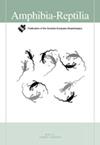Skeletal morphology and fluctuating asymmetry of the European green toad, Bufotes viridis, in contrasting habitats
IF 1.3
4区 生物学
Q3 ZOOLOGY
引用次数: 2
Abstract
Current environment changes and global amphibian decline suggest specific responses assuming urbanisation potential of the species. Amphibians are generally considered to be suitable bio-indicators of environmental health due to their ecological requirements. Therefore, fluctuating asymmetry (FA), a measure of small random deviations from bilateral symmetry is used for assessing morphological disruptions and parallelly the environment health. We measured the snout-vent length and lengths of five skeletal traits of limbs (humerus, radioulna, femur, tibiofibula, calcaneus) among the five European green toad populations from two contrasting habitats (urban and rural). We did not confirm our hypothesis that urban populations would exhibit higher level of FA as an indicator of higher environmental stress comparing to rural populations. However, asymmetry measured on forelimb bones was significantly larger than on hindlimbs. In addition, one urban population had significantly longer limbs comparing to the other sites.欧洲绿蟾蜍在不同生境中的骨骼形态和波动不对称性
当前的环境变化和全球两栖动物的减少表明,假设该物种具有城市化潜力,就会有具体的反应。由于两栖动物的生态要求,它们通常被认为是环境健康的合适生物指标。因此,波动不对称性(FA),一种测量双侧对称性的小随机偏差的方法,用于评估形态破坏和平行的环境健康。我们测量了来自两个不同栖息地(城市和农村)的五个欧洲绿蟾蜍种群的五个四肢骨骼特征(肱骨、桡尺骨、股骨、胫腓骨、跟骨)的口鼻部长度和长度。我们没有证实我们的假设,即与农村人口相比,城市人口将表现出更高水平的FA,作为更高环境压力的指标。然而,前肢骨骼的不对称性明显大于后肢。此外,与其他地点相比,一个城市人口的四肢明显更长。
本文章由计算机程序翻译,如有差异,请以英文原文为准。
求助全文
约1分钟内获得全文
求助全文
来源期刊

Amphibia-Reptilia
生物-动物学
CiteScore
3.10
自引率
6.20%
发文量
39
审稿时长
6-12 weeks
期刊介绍:
Amphibia-Reptilia is a leading European multi-disciplinary journal devoted to most of the aspects of herpetology: ecology, behaviour, evolution, conservation, physiology, morphology, paleontology, genetics, and systematics.
Amphibia-Reptilia publishes high quality original papers, short-notes, reviews, book reviews and news of the Societas Europaea Herpetologica (SEH). The Societas Europaea Herpteologica (SEH) website is located at: www.seh-herpetology.org.
 求助内容:
求助内容: 应助结果提醒方式:
应助结果提醒方式:


